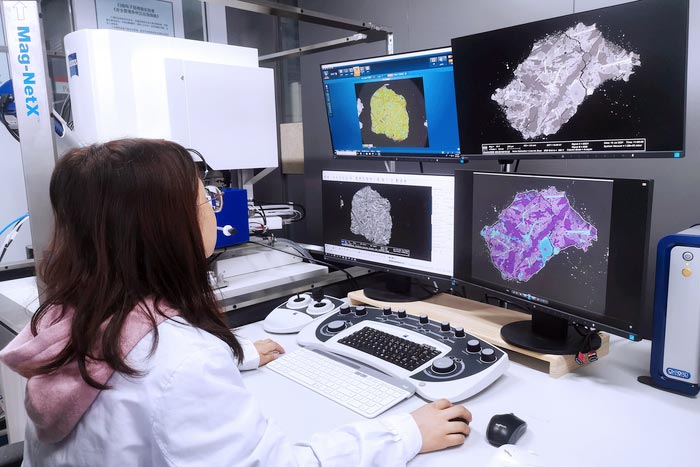Chang’E-5 samples reveal how young volcanism occurred on the Moon

Dr. YUAN Jiangyan analyzes Chang’E-5 lunar samples with a scanning electron microscope at IGGCAS
Credit: SU Bin
A new study led by Prof. CHEN Yi from the Institute of Geology and Geophysics of the Chinese Academy of Sciences (IGGCAS) provides an answer to the question of how young volcanism occurred on the Moon.
The researchers found that mantle melting-point depression due to the presence of fusible, easily melted components could generate young lunar volcanism.
Their findings were published in Science Advances on Oct. 21.
Lunar samples returned by the Apollo and Luna missions are all older than about 3 billion years, leading scientists to suppose that the Moon has been geologically dead since then. However, the new lunar samples returned by China’s Chang’E-5 mission in 2020 revealed surprisingly young volcanic activity only 2 billion years old.
For the small rocky Moon, the heat fueling volcanic activity should have been lost long before these eruptions 2 billion years ago.
So what’s going on? Scientists previously speculated that either elevated water content or heat-producing elements in the lunar interior might have driven volcanism in the late stage of the Moon’s life. But the Chang’E-5 data recently published in Nature have ruled out these once-leading hypotheses.
“Recent melting of the lunar mantle can be achieved by either raising the temperature or lowering the melting point. To better understand this problem, we should estimate the temperature and pressure in which the young volcanism was created,” said Prof. CHEN.
The researchers conducted a series of fractional crystallization and lunar mantle melting simulations to compare 27 precious Chang’E-5 basalt clasts with Apollo basalts. They found that the young Chang’E-5-source magma had higher calcium oxide and titanium dioxide contents than older Apollo magmas.
“This is a fascinating result, indicating a significant contribution of late-stage lunar magma ocean cumulates to the Chang’E-5 volcanic formation,” said Dr. SU Bin, first author of the study.
Because the late-stage lunar magma ocean cumulates are calcium-titanium-rich and more easily melted than early cumulates, adding these fusible components to the lunar interior through gravitationally driven mantle overturn could have efficiently reduced the mantle melting temperature and thus triggered the young lunar volcanism.
“We discovered that the Chang’E-5 magma was produced at similar depths but 80 degrees Celsius cooler than older Apollo magmas. That means the lunar mantle experienced a sustained, slow cooling of 80 degrees Celsius from some 3 billion years to 2 billion years ago,” said Dr. SU.
This work presents evidence for the first viable mechanism to account for young volcanism on the Moon that is compatible with the newly returned Chang’E-5 samples. This study can help planetary scientists better understand the Moon’s thermal and magmatic evolution.
Journal: Science Advances
DOI: 10.1126/sciadv.abn2103
Article Title: Fusible mantle cumulates trigger young mare volcanism on the cooling Moon
Article Publication Date: 21-Oct-2022
Media Contact
SU Bin
Institute of Geology and Geophysics, Chinese Academy of Sciences
subin@mail.iggcas.ac.cn
All latest news from the category: Earth Sciences
Earth Sciences (also referred to as Geosciences), which deals with basic issues surrounding our planet, plays a vital role in the area of energy and raw materials supply.
Earth Sciences comprises subjects such as geology, geography, geological informatics, paleontology, mineralogy, petrography, crystallography, geophysics, geodesy, glaciology, cartography, photogrammetry, meteorology and seismology, early-warning systems, earthquake research and polar research.
Newest articles

Properties of new materials for microchips
… can now be measured well. Reseachers of Delft University of Technology demonstrated measuring performance properties of ultrathin silicon membranes. Making ever smaller and more powerful chips requires new ultrathin…

Floating solar’s potential
… to support sustainable development by addressing climate, water, and energy goals holistically. A new study published this week in Nature Energy raises the potential for floating solar photovoltaics (FPV)…

Skyrmions move at record speeds
… a step towards the computing of the future. An international research team led by scientists from the CNRS1 has discovered that the magnetic nanobubbles2 known as skyrmions can be…




















